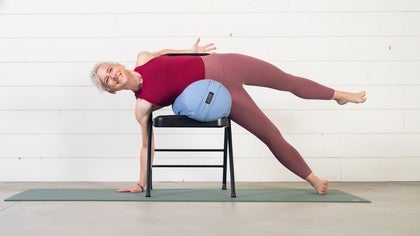
You and Your Spine: A Partnership in Healing Back Pain
What’s your relationship with your spine like these days? Are you two on good terms? Are you afraid of your spine? Is it yelling at you - again? Well, perhaps this article can be the therapist you and your spine need to reconcile. The altar of the yogi is the spine. Understand your spine, learn to speak its language, and you might find yourself feeling stronger, more confident, and more capable.
Note: This article will focus on chronic, nagging back pain. If your pain is acute - meaning a discomfort that is relatively new, developed from a new exercise routine or recent injury - I would suggest finding a wise teacher you genuinely trust and move with confidence and caution. Here, we will focus on conquering persistent, recurring pain.
I was enjoying a finishing-touch supine twist at the Ojai Yoga Crib; Saul David Raye’s afternoon class was ending, the doors and windows of the venue were wide open, slanted sunbeams streamed through the room and I basked in the remaining moments of live music and fresh air.
Spinal twists can do that to you; they’re powerful. I was absorbed in the stretch in such a way that Saul’s voice seemed distant. But I was plucked from my reverie when Saul implored us, in that smooth-as-honey voice of his, to “become best friends with your spine.”
I’d had recurring neck pain for years, despite all my yoga. I had never considered that the issue wasn’t just in my neck, but possibly involved my spine as a whole. Perhaps this was what I was missing: a partnership with my spine. But how could I develop that?
The simple answer: get to know your spine.
Trusting the structure
Let’s start with the anatomy. Anatomical wisdom makes the healing process far less intimidating. Once you understand the anatomy of the spine, noting all the rigging of ligaments and wrappings of fascia, you may be convinced that your spine is indeed robust. You may begin to believe in your spine; trust it. As the late Dr. John Sarno says in his book Healing Back Pain, you may stop being “intimidated by back pain” and realize that “you have the power to overcome it.”
Structurally, when imagining the tower of your spine, picture the Transamerica Pyramid instead of Empire State Building. In its architecture, like the famous skyscraper of the San Francisco skyline, your spine has more girth at its base and tapers upwards. Five stout lumbar vertebrae comprise the base and the spine narrows slightly as it moves up to the twelve more slender cervical bones of the neck.
(A hint for remembering the number of bones in each section of the spine: you have breakfast at 7, lunch at 12 noon, and dinner at 5. There are 7 cervical vertebrae in the neck, 12 thoracic vertebrae attached to the ribcage, and 5 lumbar vertebrae of the low back.)
Why this discrepancy in vertebral structure?
By the time the spinal cord has reached the low back, most of the nerves have already branched off to travel out into the body. This means that the opening for the spinal cord (called the foramen), is smaller in the lumbar vertebrae so that more of the vertebral space is allocated to bone density. In an individual lumbar vertebra there is more bone and less foramen.
Cliff notes’ version: the low back is not an area of the body that should conjure delicacy. The bones are sturdy and the spinal cord is narrowing.
The cervical spine, on the other hand, has the opposite situation: the nerve bundle is thicker and yet the vertebrae surrounding them are modest. Converse to the lumbar spine, the cervical vertebrae have more foramen and less bone. Slighter bones accommodate the thick bundle of nerves closer to the brain. This gives the cervical spine (the neck) much more mobility than the two lower sections of the spine (thoracic and lumbar).
The neck should conjure in you a sense of gentleness - with the broader range of mobility provided by the neck, comes volatility.
Understanding the different sections of the spine sounds simple enough – don’t be afraid to move your low back and handle your neck with caution – but this common sense is rare. As a yoga teacher, I regularly saw students with chronic back pain who were terrified to move their lower spines but cranked their cervical spine into “neck stretches” that made me wince.
Most of us aren’t thinking of our spines as divided into different sections with varying levels of mobility. Shoot, most of us aren’t thinking of our spines at all. When was the last time you genuinely spent time meditating on the spine? Try it. It might help whether you have back aches or not.
Myth: Your spinal discs are not fried eggs
Another tip that might help those with chronic back pain is to know that your spinal discs are safeguarded. Throw out terms like "slipped disc" because the term is inaccurate, since spinal discs have no chance of sliding out of place, seeing as they are secured to the vertebrae above and below them.
The thought of a disc slipping in your vertebral column gives the impression that a disc could slide out from between the vertebrae like a fried egg might slide out of a breakfast sandwich. This is not the case.
A disc may bulge or even eventually herniate, but it does not just slide around haphazardly between the vertebrae. The spinal discs – all 23 of them – are wrapped in rings of thick fascia (think of the rings of an onion) that surrounds the gelatinous center, a webbing that is embedded in the vertebrae above and below each disc.
Picture a jelly donut with a luscious jelly center, but instead of the pillowy dough surrounding it, imagine a fibrous coating of something more along the lines of celery.
The gelatinous core of spinal discs is well protected and pressurized in their fascial shells. They become shock absorbers as we mobilize, and also mimic ball-bearings to accommodate for our mobility to fold forward and backward, twist, and side-bend.
As we take the spine through its range of movements, our activity squeezes and massages the discs, encouraging fluid exchange. As you move the spine with intention, you’re circulating the fluid of the spine and hydrating the spinal discs.
This is why yoga – when done safely under the guidance of a wise teacher – can be so beneficial for the spine. Yoga poses use techniques of tension and compression to “stress” the tissue into aliveness. Movements and stretches provoke our joints – in a good way - to encourage healthy cell maintenance.
It’s worth emphasizing, amongst all this talk of spinal structure, that the spinal cord does not run through the discs. When we hear descriptions like “pinched” or “bulging”, it can conjure images to the contrary; but as this article mentioned before, there is an opening (the foramen) in each of your vertebrae behind the disc that creates a cage of protection for the precious spinal cord to pass through. The spinal structure is secure, built with a beautiful balance of movement and stability in mind.
Worshipping at the altar of the spine
If there is one thing I hope you take away from this article, it is that the spine is not something to fear. Nurture it, sure, but don’t coddle it. You want to develop a relationship with the spine and this process sometimes requires having difficult conversations to experience peaceful coexistence.
If your body is your temple, treat your spine as the altar. Sounds emotional, because it is! The spine is an anatomical entity for which you can be passionate, especially if you are experiencing chronic back pain.
Dr. Sarno encourages us to think outside the box to heal our back pain and consider emotional stress as abetting persistent back pain. He pleads with his patients to resume active lifestyles, courageously moving beyond the fears associated with their pain saying that “psychological conditioning contributes to ongoing back pain.”
It may be the bravest goal you’ve ever set, to move beyond your back pain, but if you don’t, you risk divorcing your spine and therefore relinquishing mobility. Without this mobility, you won’t be able to exercise the bones and muscles of the spinal column to maintain strength. Core strength is nothing without the health of the spine. You can have the most impressive muscular abdominal wall, but if the wellbeing of your spine is not maintained, you are at the mercy of your disgruntled spinal column.
Think of the spine as the strong, silent type; an introvert. It’s not innately boisterous and only rightfully yells when it is ignored or provoked to the point where it must speak up to defend itself.
If your spine is shouting in places, start slowing down to listen. Look at anatomy books and study this structure that literally supports you. Understand the spine and I guarantee you will feel the kinship you share with your marvelous spine and perhaps, as you pay closer attention, you will feel that the discomfort remarkably subsides.
Comments
You need to be a subscriber to post a comment.
Please Log In or Create an Account to start your free trial.











